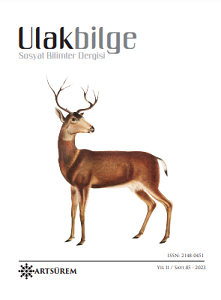İSTANBUL’UN TARİHİ SAYFİYE BÖLGELERİNE AİT HARİTALARIN DETAYLI ÇÖZÜMLENMESİ
DETAILED ANALYSIS OF HISTORICAL MAPS OF ISTANBUL'S SEASIDE RETREAT AREAS
Author(s): Nefise Burcu Yağan KöylüSubject(s): Historical Geography, Maps / Cartography, Recent History (1900 till today), 19th Century
Published by: Sanat ve Dil Araştırmaları Enstitüsü
Keywords: The historical maps of İstanbul; the concept of sayfiye; resort area; 19th century; 20th century;
Summary/Abstract: Situated in special geography where two continents are connected and served as the capital of the Roman, Byzantine, and Ottoman empires, Istanbul has a remarkably important position in the world with thousand years of its cultural heritage. The existence of the city has intrigued cartographers of every period and a great number of city’s maps have been produced over time. The first meaning of the sayfiye is a cottage, summer house, while its second meaning is a rural area close to the city and it originated from Arabic. Conceptually, "sayfiye" refers to an area with settlements of summer, plus, a building used in summer. The sayfiye areas, which began to thrive in the city center of Istanbul in the mid19th century, have been in a process of expansion and transformation that has evolved towards the urban area since they first emerged. This process can only be assessed by reviewing and analyzing the written and visual documents of Istanbul. Hence, maps are an important tool. When the Istanbul maps were being made, Galata-Pera and the Historical Peninsula were in the foreground, where the settlement was more concentrated than the sayfiye areas, whereas the sayfiye areas remained in the background. This study is remarkable as it focuses on the maps of Istanbul's sayfiye areas. The study aims to determine the maps of Istanbul's sayfiye areas, systematize the maps, and identify the map features. Thus, it is aimed that researchers studying the specified areas will be able to access information about the names and features of the maps more easily. In the introduction, information about Istanbul maps and summer areas was presented, after defining the objective, scope, method, and current literature, the development process of Istanbul maps was explained in the first chapter. In the second chapter, after the maps were categorized based on the size of the area they cover, the features of the maps were assessed through this classification. In the final chapter, the obtained and revealed results were discussed.
Journal: Ulakbilge Sosyal Bilimler Dergisi
- Issue Year: 11/2023
- Issue No: 85
- Page Range: 527-557
- Page Count: 31
- Language: Turkish

